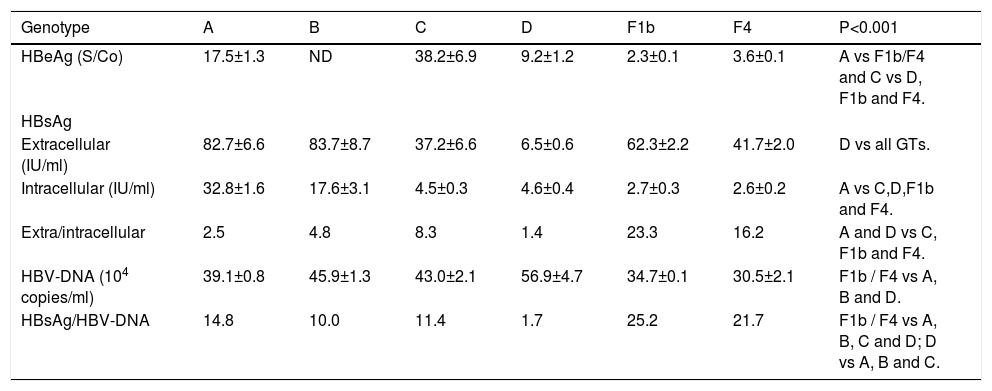
Abstracts of the 2021 Annual meeting of the ALEH (Asociación Latinoamericana para el Estudio del Hígado)
Más datosHepatitis B virus (HBV) has been classified into 10 genotypes (A-I) and numerous subgenotypes (SGTs). There is growing evidence that HBV genotypes (GTs) influence clinical outcomes, HBeAg seroconversion rates, severity of liver disease, and response to interferon therapy. However, there is a paucity of data regarding their distinctive biological characteristics, in particular for GTF, the most prevalent in Latin America.
AimTo investigate the impact of HBV genotypes on HBV-DNA levels and viral antigen expression.
Materials and MethodsFull-length HBV genomes representing GTs A-D and SGTs F1b and F4 were transfected in Huh7 cell line. Secreted HBeAg and intra and extracellular HBsAg were quantified by EIA. HBV-DNA was analyzed by real-time PCR.
ResultsMarked differences were observed in HBV replicative capacity as well as HBeAg and HBsAg antigen expression across genotypes (Table 1). GTC secreted significantly higher levels of HBeAg in relation to the other GTs. GTD showed lower HBsAg extracellular levels than all other GTs, while GTA showed the highest HBsAg intracellular levels. Finally, SGTs F1b and F4 showed significantly lower HBV-DNA levels. Regarding the ratio of extra and intracellular HBsAg, GTs A and D showed the lower ratios compared to SGTs F1b and F4, while SGTs F1b and F4 showed the highest HBsAg/HBV-DNA ratio.
DiscussionThis study provides new insights into the impact of HBV genotypes on HBV antigen expression and HBV-DNA levels. The uneven expression of antigens, as well as their intracellular accumulation, could be associated with the role of genotypes in pathogenesis. Likewise, the extracellular levels of HBsAg and the replication rate might have implications in immunopathogenesis as well as in the exhaustion of the host's immune system. The virus-cell interaction in different genotypes deserves further study to understand its role in the pathogenesis of HBV infection.









